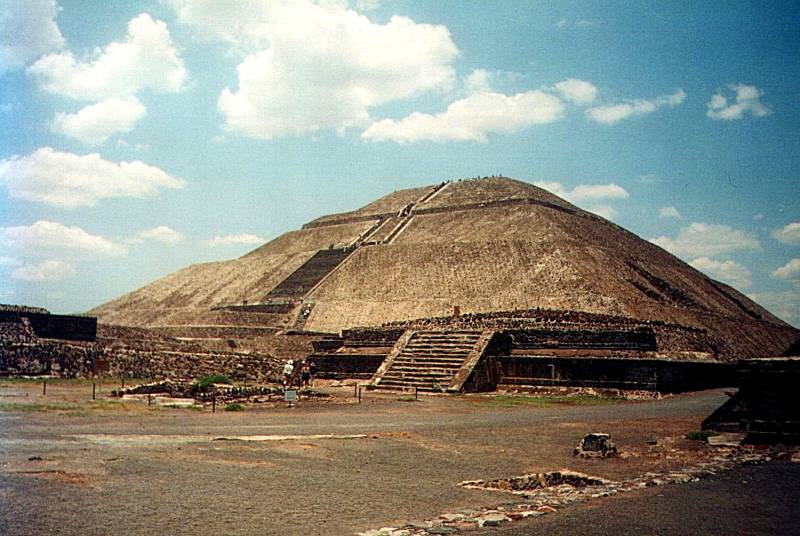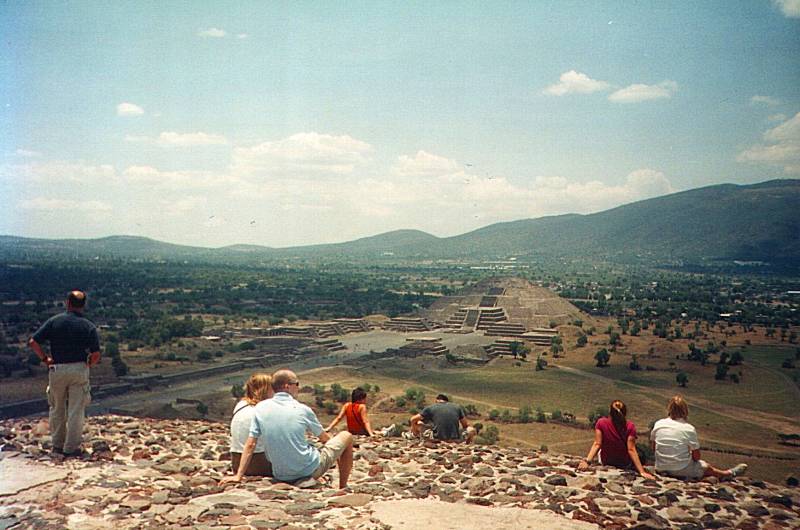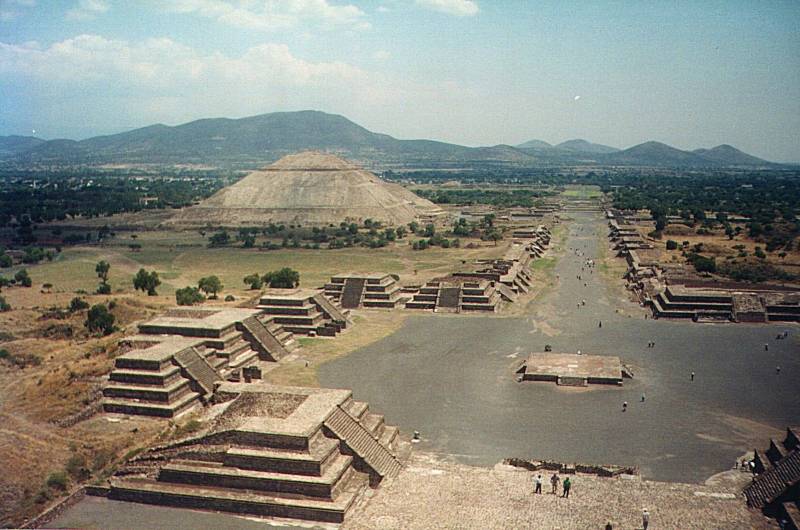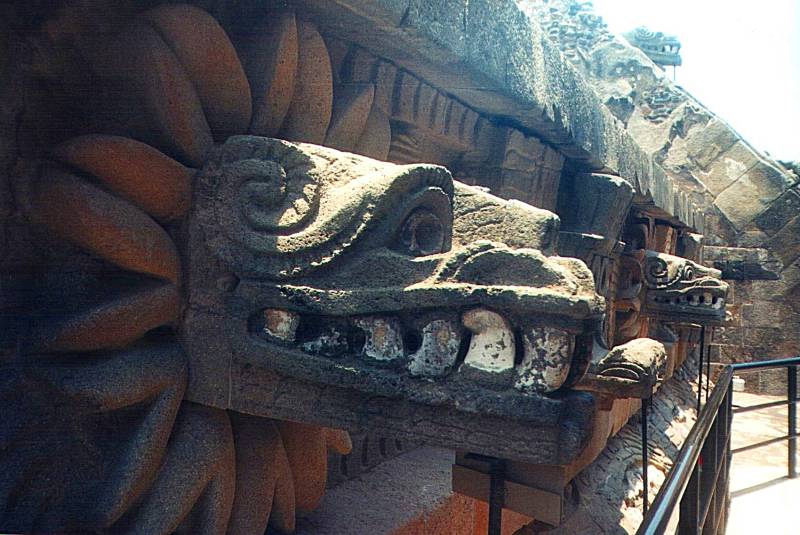
Teotihuacán
The Pyramids of Teotihuacán
Teotihuacán is a very impressive ancient religious center with enormous pyramids. It's an easy day trip out of Ciudad de México, as it is only about 40 kilometers outside the city. There are buses from Mexico City's Terminal Norte every 15 minutes through the day. Just make sure that you get one to Los Pirámides and not to the town of San Juan Teotihuacán.

Teotihuacán was established some time around 100 BCE, and it was the largest city in the Americas at its peak from 150 to 450 CE. It probably covered over 30 square kilometers and had more than 150,000 inhabitants, possibly 250,000, making it among the largest cities in the world at that time.

One of the strange things about the place is that we don't know the name of the city! Teotihuacán is the Nahuatl name applied by the Aztec centuries after its fall. It means either "birthplace of the gods" or "place of those who have the road of the gods", reflecting their belief in its significance.
The Nahuatl name would be pronounced Teotihuáacan, the Spanish is Teotihuacán.
Hieroglyphic texts from the Mayan regions of Yucatan refer to the city as Puh or Place of Reeds.
It seems that it was a multi-ethnic city with quarters occupied by different people: the Otomi, Zapotec, Mixtec, Maya, and Nahua. Both the Totonacs and Aztecs have claimed to have been the builders, but there is no archaeological evidence for either having done so.
The Pirámide del Sol or the Pyramid of the Sun is the third-largest pyramid in the world as measured by volume. It's 70m high, 220m along each face of the base, thus with a slope of about 33 degrees on each face. It was completed by 100 CE.
Just like the city, the Aztecs named the pyramid centuries after the city was abandoned, and so we don't know the original name. Its initial phase of construction yielded something very similar to what we see today by about 100 CE. A second phase of construction enlarged it slightly overall, adding an alter on its top platform.
The ancient inhabitants of Teotihuacán finished the pyramid with a coat of lime plaster, and painted brightly colored murals on that. Neither the paint nor the plaster are visible today. Murals, perhaps tens of thousands of them, covered many of the city's buildings. Some writers have compared the painters' artistry at their peak to that of Florence during the Renaissance. Other craftsmen were creating a large number of obsidian artifacts.
It is thought that the pyramid was devoted to a single deity, but the destruction of the altar at the top before the historical period prevents identifying just which deity this might have been.
At one end of the long complex is the Pirámide de la Luna or Pyramid of the Moon, not quite as big but still huge. Its peak is 42 meters high and it's 150 meters wide at its base.

We're on top of Pirámide del Sol and looking toward Pirámide de la Luna. Because of the rising elevation of the ground, the tops of the two pyramids are almost exactly level despite their differing heights.
The Pyramid of the Moon has contours mimicing those of the mountain Cerro Gordo to the north of the city. It was built after the Pyramid of the Sun, between 200 and 450 CE.
The platform on top of the pyramid was used for ceremonies honoring the Great Goddess of Teotihuacán, the goddess of water, fertility, the earth, and creation. She was a predecessor of the much later Aztec goddess Xochiquetzal.
The Plaza of the Moon is directly in front of the pyramid, leading to the Avenue of the Dead or the Miccoatli in Nahuatl.
Here you see Pirámide de la Luna and some of the relatively smaller (but still quite large!) ritualistic structures surrounding the Plaza of the Moon. These were initially thought to be tombs, but study has shown that they were ceremonial platforms topped with temples.

Now we're on top of Pirámide de la Luna and looking out over the Plaza of the Moon and the many smaller ritualistic structures, down the Avenue of the Dead and past Pirámide del Sol toward La Ciudadela and the Temple of Quetzalcoatl.

The entire site is aligned so that its nominal north-south axis is aligned 15.5° east of north. There are theories that this was used to mark certain days of the calendar year when the sun rose or set aligned with the nominal east-west lines. However, it seems that Teotihuacán's grid is aligned toward the tallest mountain in the area. That mountain is not visible from the city itself, its view blocked by lower but closer mountains, but some cross symbols pecked into stone through the city and its surroundings seem to have been used to align the urban grid to the unseen mountain.
Historians had thought that invaders sacked and burned the city in the 7th or 8th century, but recently discovered evidence shows that the burning was limited to structures associated with the elite class. This suggests that the burning of the city before its abandonment may have been caused by an internal uprising. The decline before the final fall has been correlated to lengthy droughts in the 530s CE. Whatever the story of its final days, Teotihuacán had been a contemporary of Rome at its height, was probably significantly larger in population, and it was still flourishing after Rome had largely been abandoned.

This sculpture depicts Quetzalcoatl, the Great Winged Serpent. He was a Mesoamerican diety whose name in the Nahuatl language literally means Feathered Serpent. This is on the Temple of the Feathered Serpent or the Temple of Quetzalcoatl, the third largest pyramid at Teotihuacán. It's a six-level step pyramid, decorated with feathered serpent head alternating with heads of another snake like deity. Under each row of heads is a bas-relief of the full length of the feathered serpent, shown in profile and associated with water symbols.
This temple is within the Ciudadela or Citadel complex, named by the Spanish who assumed it was a fort. It was instead a ritual center capable of holding the entire adult population of the city.
My page on Tepoztlan, the supposed birthplace of Quetzalcoatl, has more on his supposed origin and background.
Quetzalcoatl was believed to be one of the four sons of Ometecuhtli and Omecihuatl; he was the god of the morning star and his twin brother Xolotl was the god of the evening star. Xolotl sounds like a new product from Eli Lilly or Pfizer.
Side effects of Xolotl may include death, resurrection, and seduction by the celibate priestess Quetzalpetlatl. Contact your physician immediately if you experience blindness or a flow of life-giving blood from a wound in your penis. Ask your doctor if you are healthy enough to engage in asexual reproduction before taking Xolotl.
Quetzalcoatl was revered as the inventor of writing and the calendar, the giver of maize to mankind, and as a symbol of death and resurrection. Also, after the destruction of the world at the end of the fourth cycle of the sun, he helped to create fifth-world mankind (that's the Aztecs and us) from the bones of the previous races.
Histories used to say that the Aztec Emperor Moctezuma II initially believed that the 1519 landing of Hernán Cortés was the return of Quetzalcoatl. However, most historians today believe that this was based entirely on Spanish reports back to the king, trying to depict the Aztecs as extremely naïve and ready for conquest.
Reports written by the Spanish after the event describe Moctezuma II offering Cortés his throne in extremely polite form. What they didn't realize is that extreme politeness in Nahuatl high rhetoric asserted dominance and demonstrated superiority.
Also, many Franciscan historians at the time held Millennarian beliefs, some of them believing that Cortés' arrival in the New World would begin the final wave of world evangelization. Some of them even thought that Saint Thomas, already believed on little evidence to have visited India, had kept going all the way across Asia and the Pacific Ocean and the Aztecs were referring to Saint Thomas when they talked of an expectation that Quetzalcoatl would return.
See the book The Bearded White God of Ancient America: The Legend of Quetzalcoatl for some details. Google Books will show you a few pages of it.
Amazon
ASIN: 1555177476
Some scholars of The Church of Jesus Christ of Latter-Day Saints, better known as the Mormons, believe that Quetzalcoatl was actually Jesus Christ.
Jesus was a feathered serpent?
No, they think that Quetzalcoatl was a white, bearded god who came from the sky and promised to return.
Jesus was white like the northwestern Europeans? I thought he was from the Middle East.
Well, according to the Mormons, he was white. At least until 1978, anyway. It's God's doing, they point out, as he was the source of their pre-1978 ban on black men joining the priesthood and participating in some temple ceremonies.
Church president John Taylor wrote, "The story of the life of the Mexican divinity, Quetzalcoatl, closely resembles that of the Savior; so close, indeed, that we can come to no other conclusion than that Quetzalcoatl and Christ are the same being. But the history of the former has been handed down to us through an impure Lamanitish source." The Lamanites, according to the Mormons, were a dark-skinned nation of indigenous Americans that battled the light-skinned Nephite nation. Until 1981, the Book of Mormon said that modern-day Lamanites (that is, Native Americans) would become "a white and a delightsome people" once they accepted the gospel.